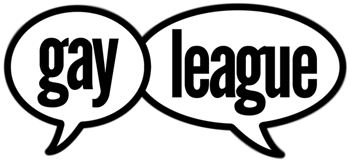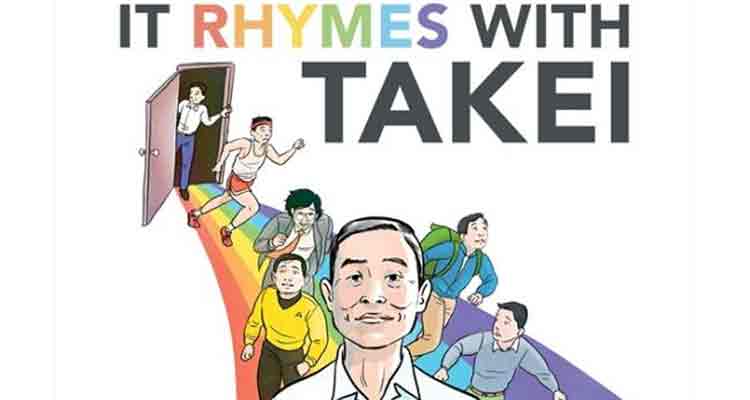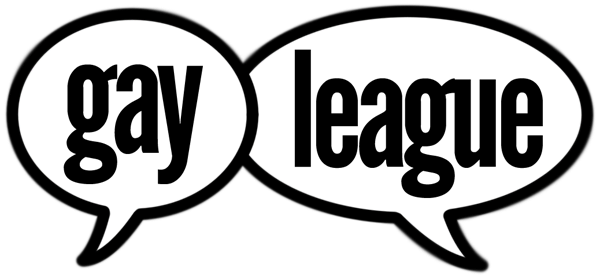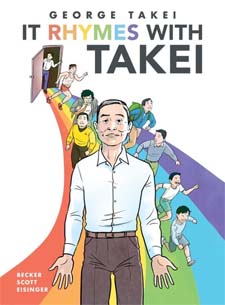
It Rhymes With Takei
George Takei, Steven Scott, and Justin Eisinger – writers
Harmony Becker – artist
$29.99
Top Shelf Productions
“Something similar, but not quite the same.”
George Takei, on living his life as a closeted gay man
Actor, activist, author, advocate, speaker, social media royalty, husband, brother, son and out and proud gay man. George Takei is all of these and more. Takei’s voice has a distinctive baritone quality that is memorable in itself but more so because Takei draws upon a life full of experiences, insights, and compassion that make his words resonate with meaning. When he talks we listen. When he laughs it brings smiles. Upon the recent occasion of his 88th birthday, Takei entered his second childhood according to the Japanese tradition of Beiju. Takei is also an elder of the LGBTQA community and a supporter of all minority peoples.
In short, Takei is living history. This truth was evident in Takei’s first graphic memoir, They Called Us Enemy, in which Takei recounted the heartbreaking experiences he and his family and 120,000 other Japanese Americans endured while incarcerated at internment camps on US soil simply because they looked differently from their fellow white Americans. With Takei’s new book, It Rhymes With Takei, the beloved cultural icon shares stories from his decades long journey of balancing his public persona with his private life and his decision to come out at the age of 68.
Harmony Becker’s cover alludes to different periods in Takei’s remarkable life, a life whose path which had its challenges. It was during the internment period that Takei’s first inkling of being gay happened. Young George’s only recourse was to hide this part of himself after none of the other boys showed a similar interest. Thanks to a Buddhist upbringing Takei was not taught to hate himself as teens in evangelical and conservative households are taught. Nevertheless Takei decided to hide his feelings out of fear of punishment that might await him if his secret were discovered. The stigma of incarceration was profound and so young Takei became the perfect child and absorbed himself in school and volunteer work.
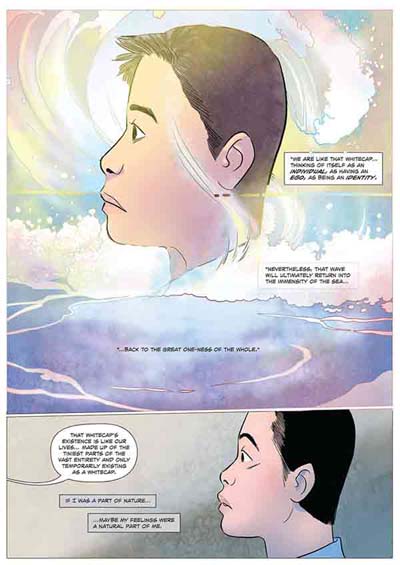
We see discrimination’s lingering effect in George’s life with a bigoted teacher and how several events in the 1950s left their marks on him. While in high school a stint working as a picker in strawberry fields angered George upon discovering Japanese American bosses taking advantage of the Mexican farm hands. A passion for activism was born after seeing the immediate change he made. A theater volunteer job leaves George utterly consumed with the idea to pursue acting as a career. In today’s world where queer media in the form of comics, books, music, movies and television to porn and more are as close as your phone it can be difficult for some people to imagine a time when queer representation was suppressed but the “Golden Age” of the 1950s was mostly an illusion. The specter of McCarthyism and the blacklisted Hollywood Ten and Lavender Scare were never far from Takei’s mind and the discovery that his movie crush Tab Hunter had been outed in a Hollywood gossip rag convinced Takei he had to stay in the closet if he wanted to be an actor.
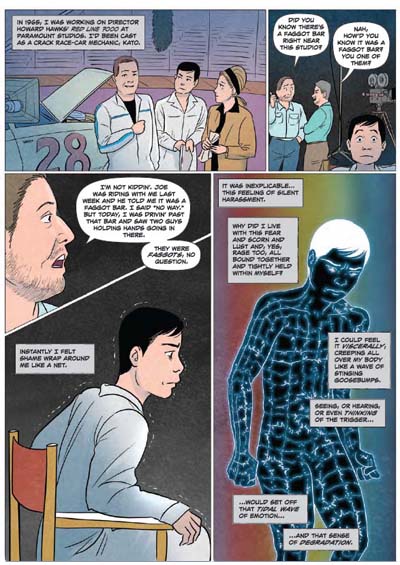
From the start of the 1960s Takei’s life takes off. An adventure in Europe opens his eyes to more of life’s possibilities while acting, activism, and volunteerism become his central pursuits. Takei volunteered for presidential campaign then on to a role in the Civil Rights inspired Fly Blackbird play then to movie roles to the Watts Rebellion which would have led to more activist inspired theater work if not for being cast as Sulu in Gene Roddenberry’s Star Trek. The Vietnam War was a flash point in American culture and Takei was active in the peace movement. These passions continue to be major parts in his life though their forms may have changed. Love finds George after he tests coming out to a small circle of gay in a running club which journalist Brad Altman also joins. Reading how George and Brad’s relationship grows and the ways they complement each other is a beautiful affirmation.
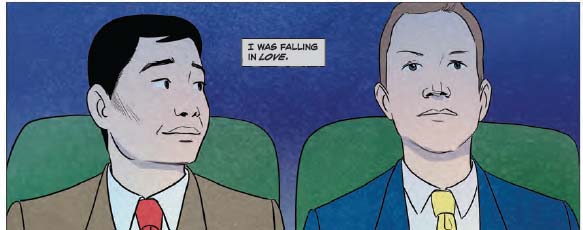
Certainly there is a great deal more that happened in the span of Takei’s life but I fear delineating those events risks making this less a review than a book report. Suffice to say there are anecdotes about Takei’s relationships with other Star Trek actors, a period of public service that drew upon his love of architecture, and the feeling of betrayal by Governor Arnold Schwarzenegger in the fight for same sex marriage. The latter being the catalyst for Takei’s openness in an interview about his sexuality and relationship with Altman. There are painfully candid moments as well. A relationship built on lies ends disastrously. The heartbreak of rejection from a beloved person who couldn’t accept Takei’s truth. We see the complex emotional cycle of fear, anger, sorrow, and relief George and Brad face in the early years of the AIDS epidemic.
Let’s return for a moment to Becker’s cover art illustrating younger versions of Takei moving along a rainbow, a bridge of sorts, away from Takei in the moment of the decision to come out publicly, and moving toward a calm Takei standing tall with pride. His outwardly facing palms appear to be an expression of the Varada mudra symbolizing compassion, charity, and generosity according to Hindu and Buddhist beliefs. Compassion for his younger self who was afraid to come out? Compassion for other people in difficult situations? Yes, in answer to both, I believe so. The composition against a seemingly unbounded field of white – white being the sum of all color in the natural world and a symbol of Buddhist spiritual virtues…clarity of perception, purity, peace, learning, and knowledge. Might this be an instance of a reviewer incorrectly reading an artist’s work? Perhaps. Consider this sequence of panels depicting Takei in a long, dark, confining hallway that eventually leads to the door we see on the front cover.
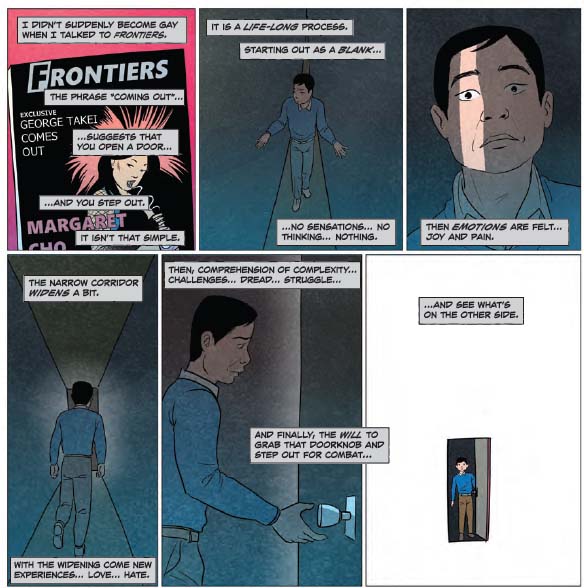
Takei’s memoir reminds us that there is no “one size fits all” coming out approach for queer people to use. There is no “recommended timeline” for us to zip along from our first inkling of being different to self acceptance and on to living out of the closet with pride. Instead it’s often a drawn out and erratic path that makes us ask “does this make me feel safe?” and “can I continue to live this way?” A universal quality of emotions, concerns, and experiences persists. Some queer people may never come out if they’re unable to accept their sexuality or gender identity let alone feel safe enough to come out. All we can do is to help continue to pave the way by fighting the big and small battles, respecting the dignity of all our queer siblings, and living our lives in the best ways possible.
It Rhymes With Takei is a portrait of an exceptional man whose life was often charted through difficult times. At a time when everything feels terrible Takei reminds us that queer people have faced challenges before and that with hope, bravery, and courage we must rise to the challenge and thrive.
Top Shelf shared several preview pages and you can watch the book’s trailer here.
It Rhymes With Takei is in comic shops and bookstores now. Comic Shop Locator will help you find a comic shop. Please support local indy bookstores. Copies of Takei’s graphic novel can be ordered through Bookshop. The ISBN is ISBN 978-1-60309-574-7. Want to shop in person and can’t find a store? Bookshop has you covered! https://bookshop.org/pages/bookstores
Other regional and national retailers are listed on this page.
It all else fails or you prefer, Amazon has copies as well.
A few notes which I think are relevant for a little more context but I didn’t want to bog down the review.
George’s work as a crop picker came about as INS, ICE’s forerunner, launched a mass deportation against Mexican immigrants who were legally permitted to work in the US as farm laborers under the Bracero Program. The deportation was given the indisputably racist name “Operation Wetback.” Read more about it at Equal Justice Initiative.
As terrible and relentless as Joseph McCarthy and his supporters were McCarthyism wasn’t the only thing closeted Americans had to be concerned about. In David J Johnson’s book Buying Gay one of the topics the author discusses is the role of physique magazines played for closeted gay and bi men across the US from the 1940s through the early 1960s. Such magazines often carried ads for “physique model” photos. Take photographer Bob Mizer and his Athletic Model Guild for example. A number of mimeographed newsletters, often including novels for purchase, were discretely distributed through the mail. These materials were considered lewd and obscene by the US Post Office. There are accounts of Postal Inspectors opening mail, resealing envelopes, and then creating sting operations threatening arrest if the targeted men didn’t give a list of names of other gay men they knew. Johnson concentrates primarily on the experiences of men during this period though similar newsletters existed for women.
The series Fellow Travelers (based on the novel by Thomas Mallon) with Matt Bomer and Jonathan Bailey is a vivid depiction of the anxiety McCarthyism caused for closeted federal employees.
The Hays Code censored Hollywood movies and TV shows from 1934 until it was finally abandoned in 1968 in favor of a rating system that with some change is still in use today. The Comics Code Authority took tips from the Hays Code.
Learn about the Watts Rebellion.

